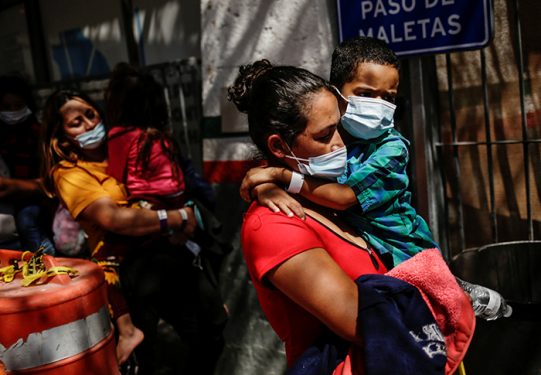
Expulsion decisions called ‘a cold calculation by numbers’

U.S. Customs and Border Protection (CBP) agents guided the families across the bridge in a single file line. Young children asked their parents where they were going. The parents, their eyes red and swollen from crying, just tried to keep the children calm.
“I felt conflicted because as we’re walking I know that they’re going to Mexico, but they don’t necessarily know at that point,” said Hanna Hollandbyrd, a policy specialist at the Hope Border Institute, an independent border advocacy organization based in El Paso. “I felt weird that I knew something that they didn’t know and that’s not fair because it’s happening to them.”
The Tablet watched with Hollandbyrd as the process unfolded, then followed the line of migrants across the bridge to Ciudad Juarez where they were directed to Mexico’s National Institute of Migration. Along the way, border patrol agents ordered pedestrian crossers to bypass the migrants and not speak to them.
Back in south Texas where these families originally crossed, the Catholic Charities of the Rio Grande Valley Humanitarian Respite Center sees 200-300 similar families — with children under the age of six — a day, according to Executive Director Sister Norma Pimentel.
Tamaulipas, the Mexican state located across from the southwest Texas portion of the border, won’t take back families with children under six. That’s why they’re flown to El Paso or San Diego and then expelled to Ciudad Juarez or Tijuana, respectively.
What’s unclear, however, is how the government decides which families get taken to the Humanitarian Respite Center to continue their journey in the U.S., and which get flown elsewhere for expulsion. Dylan Corbett, executive director of the Hope Border Institute, said it’s a question he’s asked CBP leadership a number of times, to no avail.
What he has gathered from other conversations is that “it’s a cold calculation by numbers.”
“I don’t believe there are rigorous screening protocols in place to identify vulnerable people. It’s a determination that’s made on a regular basis between border patrol at the local level in consultation with political leadership in Mexico,” Corbett said. “Basically, what happens is they will release as many people as they can, but they will do it in such a way that the perception of crisis is mitigated.”
“There’s a constant dialogue that’s taking place,” he continued. “They would say, ‘well Juarez can take this many people so that’s how many we’re going to send them. Tijuana can take this many people so this is how many we’re going to send them.’ ”
Once the migrants cross the El Paso bridge to Ciudad Juarez and arrive at Mexico’s National Institute of Migration they’re seated in rows underneath event-style tents, according to Hollandbyrd. At that point, Mexican immigration officials process them, while volunteers from different organizations — Hope Border Institute, UNICEF, and World Central Kitchen — provide essentials and meals, plus things to occupy the children like teddy bears and coloring supplies.
About 100-150 migrants daily go through this process. Eventually, they’re all released to different shelters in Ciudad Juarez. This has been the process for a few weeks.
Previously, after they were guided across the bridge, the migrants were left on the streets of Ciudad Juarez, with no direction. There was no processing facility. They were left vulnerable to the dangers that exist, which Corbett argues are still present despite a more organized system now in place.
“They’re vulnerable to many things,” Corbett said. “They’re vulnerable to smugglers. They’re vulnerable to human traffickers. They’re vulnerable to organized crime. They’re vulnerable to extortion by the national guard and by police.”
“This is just window dressing. This is palliative. They’re being put into a short-term care facility, but they’re expected to leave and then these people will be absorbed by the civil society,” he continued.
Corbett further noted that once they’re released, it’s largely the faith community that is left “picking up the pieces” with little help from the Mexican government.
“These migrants will either give up, if they’re asylum seekers they will return back to situations of danger and persecution, [or] if they decide to stay in Juarez because they need to continue to seek protection, it’ll be the faith community that stands up and is there to receive them, not the Mexican government,” Corbett said.
About two blocks from the bridge where migrants are expelled, other migrants enter the country through the Biden administration’s rollback of the Trump administration’s Migrant Protection Protocols (MPP) that made migrants wait in Mexico until their case is decided.
They’re met with applause from Hope Border Institute volunteers as they walk through CBP building doors, and are asked if they need any help before continuing their journey. Some 100-150 migrants a day have entered this way — for a total of more than 3,000 — since MPP was rolled back.
Corbett is pleased with that process, which he calls safe and compassionate. However, he recognizes what happens two blocks over and knows El Paso could do more. The reason it’s not, he noted, is due to the priorities of the U.S. government.
“The U.S. government’s main interests here are to increase the capacity of Mexico to receive expelled migrants. And to deter, to incentivize those governments to deter migrants,” Corbett said.
“We do have the ability to manage, to process asylum seekers with dignity and compassion at the border. I know that we can do it and I know that we have incredible resources at the border,” he continued. “This is a community that will rise to the challenge to receive vulnerable people who are in need of protection and refuge right now. Not tomorrow, but today. We’ll do what it takes.”
